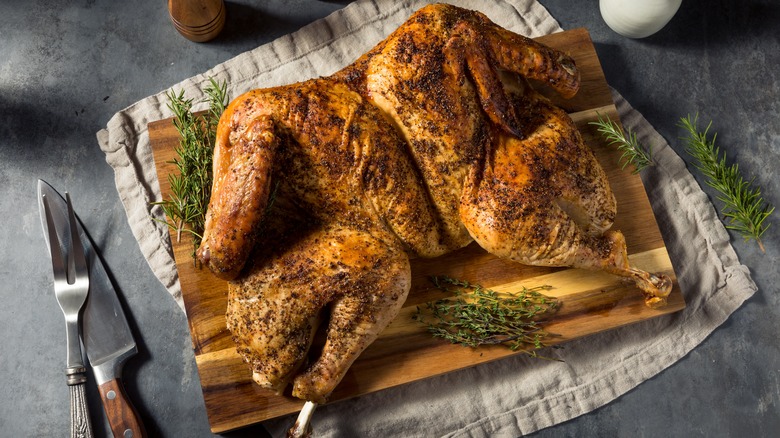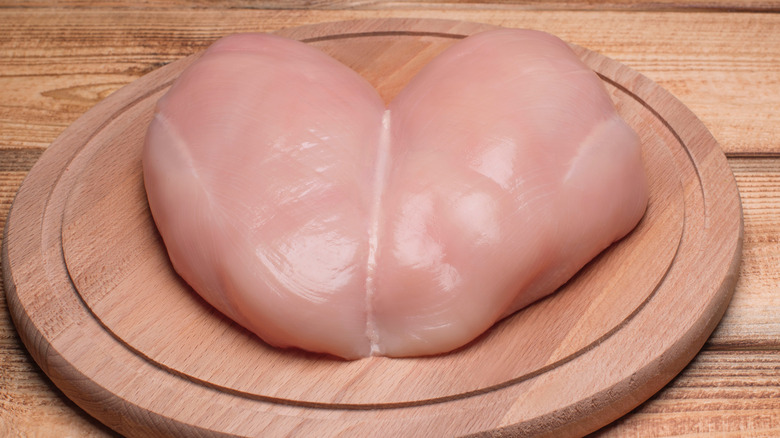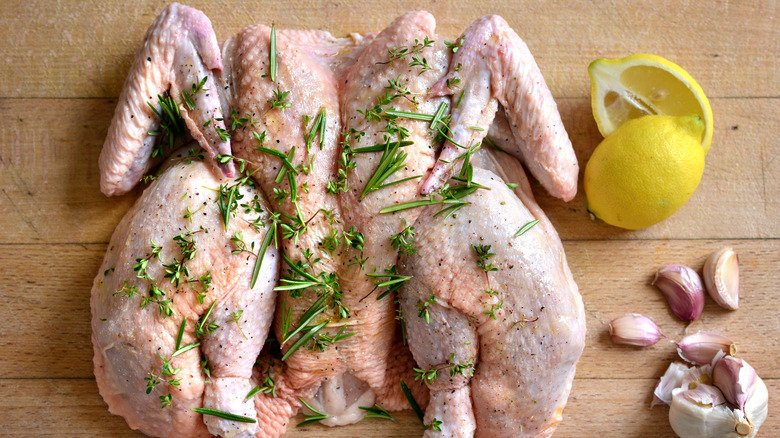The Important Differences Between Butterfly And Spatchcock Cuts
Butterflying and spatchcocking are two basic culinary techniques for carving up poultry, fish, and meat. While they may look and sound complicated, the two are fairly simple approaches once you grasp an understanding of the basics. They differ in a couple of aspects — from which animal each is used on, to why they are used and how — but ultimately the concept of the two is pretty similar.
One of the biggest differences between the methods is that only a whole chicken (or other type of whole bird) can be considered to be spatchcocked. In comparison, a butterfly cut could apply to a chicken breast, beef filet mignon, a leg of lamb, a pork chop, or a method of filleting an entire fish.
If you often end up with dry breasts and undercooked thighs when you roast a whole chicken, then spatchcocking is worth a try. On the other hand, if you like a rare-ish center to your filet of steak but not when it's stacked inches high, have a deep-rooted fear of choking on a fishbone, or just enjoy your flounder stuffed with crabmeat, a butterfly cut may be just what you're looking for.
What is a butterfly cut?
Butterflying a piece of animal protein is essentially cutting it in half horizontally, but not all the way through. The cut stops about three-quarters of the way in, so you're left with what is effectively a hinge. You are then able to open the piece of meat and lay it flat. This method cuts the thickness of the piece of meat in half while still keeping it intact as one piece, resembling a butterfly's wingspan.
Butterflying is used to reduce and even out thickness, slash cooking time, and remove bones without sacrificing the meat and ending up with two or more pieces. A butterflied chicken breast ends up looking like a heart when you open it up, and while a butterflied steak's shape will vary depending on the cut, a piece of filet mignon will resemble two connected circles, as will a butterflied pork chop. Butterflying a leg of lamb is mostly used to remove the bone, which results in a much faster cooking time and uniform thickness.
When it comes to butterflying fish, this is to debone it while keeping the head and tail still connected. Instead of two fillets that typically result from the process, butterflying leaves you with the whole fish intact sans the majority of its bones — this renders the cavity perfect for stuffing. Shrimp can also be butterflied by gently slicing down its back, but not all the way through — picture the splayed-out meat of a jumbo shrimp cocktail.
What is spatchcocking?
Spatchcocking is a technique used to cut down the cooking time of a whole bird, while ensuring even cooking and maximizing the surface area for extra-crispy skin. To spatchcock a chicken, for example, you use a pair of kitchen shears to cut right along both sides of the backbone and remove the spine. You then flip the bird over and apply pressure right at the breast bone to crack it and flatten the bird out. You're then left with one flat chicken.
When the chicken is laid flat, the darker meat will be exposed to more heat than it usually is tucked in and under the breasts and cavity. Spatchcocking allows the breasts and thighs to cook at similar lengths of time, guaranteeing tender, juicy meat from all cuts of the bird.
A spatchcocked chicken will roast in the oven at fractions of the time a whole intact one would. It also renders the bird suitable for other cooking methods, such as grilling or pan-searing, also at a much quicker pace.


